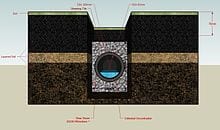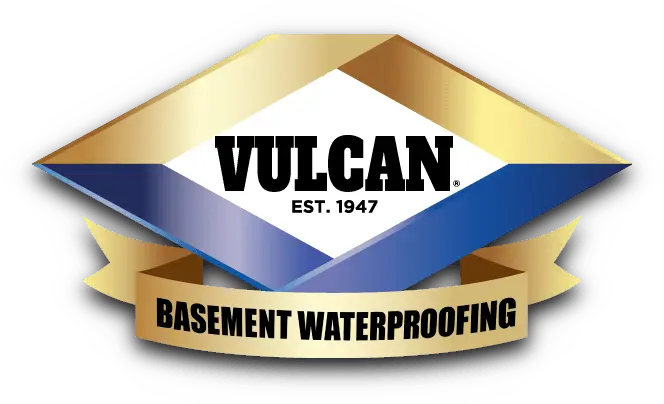“French drain” is a popular term used to describe an outdoor trench covered in rocks and connected to a series of pipes that carry water away from your house.
Sometimes, the term is confused with footing drain and perimeter drain. French drains refer to an exterior drainage system, which is located outside the house such as garden, empty lawn or backyard and it’s installed near the foundation wall.
A perimeter drain, on the other hand, refers to an interior drainage system, which is installed in your basement or crawl space (Inspectapedia, 2011).
How a French Drain System Works
Can you imagine how water flows in roof gutters? If yes, then that’s exactly how French drains work. Underground, the footing drain looks like tubular puzzles connected to each other, but with end points.
The drainage provides a channel for water to flow through (House Logic, 2009) but it differs in construction. Once it rains, the water runs freely into the perforated pipe until it’s ejected to any low area such as ditch, well or street.
If you have standing water or surface water in your basement or in your yard, you should look to us to build a French Drain to help with your drainage problem. Safeguard your yard or property by calling us now.

The Function
The primary function of a French drain, either installed externally or internally, is to protect your basement from flooding. It directs unwanted water away from the foundation.
Its other uses include water distribution similarly like a septic tank and it also acts as a support to retaining walls in an aim to reduce ground water pressure.
Installation Procedures
Exterior French drain:
A single exterior French drain requires a lot of digging (House Logic, 2011). You’re required to dig a sloping trench in the direction the water will go.
Generally, it’s recommended to have an inch slope for every eight feet in length. A fifty feet long drain means you need to dig 75 cubic feet of soil.
The installation also requires the excavation of soil around the house down to the bottom of the foundation footing. It’s a disruptive process because it requires you to remove and replace landscaping, driveways, sidewalks, porches, decks, etc. (Fine Home Building, 2002).
It’s for this reason why there is a need to fill the trench with crushed stones then, you’ll need to cover these stones with water-permeable landscaping fabric to discourage weed growth.
Next, lay the piping tubes into the trench. Either you choose a firm PVC with predrilled holes or flexible drain pipe cut with slits. The PVC is expected to last longer while a flexible pipe is inexpensive and easier to use.
Attach a 45-degree angle joint to the start of your pipeline before connecting the joint to a pipe that sticks out of the ground. You also need to wrap the landscaping fabric around the pipe to keep dirt and roots from blocking the system.
Unfortunately, you’ll complicate the future maintenance efforts if you’ll cover the pipes. It’s difficult to find and fix the problem if something goes wrong (Fine Home Building, 2002).
Interior French drain:
An interior perimeter drain puts an end to wet basements. The installation process begins by digging a trench around the floor area.
A perforated pipe is placed around the trench, which will be covered with crushed stones (Fine Home Building, 2002). Finally, concrete is poured over the trench.
Usually, the trench is connected to a sump pump. Unwanted water is stored here and will be expelled outside the house after.
Waterproofing experts recommended installing a battery backup pump with special features such as alarm system and auto-monitoring tools.
Pros & Cons of French Drains
Pros:
One
Exterior French drains might work fine for a number of years depending on site condition, installation process and maintenance.
Two
Interior French drains are easy and cheap to install as long as there’s an enough power supply and construction pit for a sump pump.
Cons:
One
Exterior French drains require a lot digging and there are times garden beds, shrubbery, porches, decks and walkways should be removed.
Two
Exterior French drain clogs if you haven’t conducted a proper maintenance. Servicing is difficult too and it might take number of days.
Three
Interior French drain costs less but it will not work effectively if it’s only installed with an ordinary sump pump.
Four
Interior French drains require more basement floor space.
Brief History of French drain
Henry Flagg French (1813-1885) was a lawyer and assistant US Treasury Secretary from Concord, Massachusetts. A French drain was born when he made sections of ordinary roofing tile and added perforations to it.
A modern version of French drain systems were made once the perforated pipe was bordered with sand landscaping textile.
These landscaping textiles were used to prevent the relocation of the drainage material while the perforated pipe provides a minor underground storage volume. Subsurface drainage systems have been used for centuries.
Vulcan Waterproofing employs a service, which is called a hydrostatic pressure relief system. It involves cutting a trench in the floor around the perimeter of the basement closed to the foundation walls.
For info or a free estimate, please call 877 885-2268 or go to:
https://www.vulcanwaterproofing.com/service-areas/delaware/
https://www.vulcanwaterproofing.com/service-areas/connecticut/
